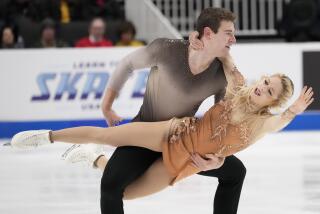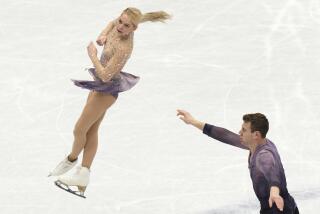National pride
- Share via
SOCHI, RUSSIA — No sport reflects Russia’s cultural legacy better than figure skating.
Go to a ballet performed by St. Petersburg’s renowned company, the Mariinsky, and you will see dancers in movements that have become essential parts of skating: spins, spirals, lifts, jumps and throws. The first dance school in St. Petersburg opened in 1738, just 35 years after Peter the Great founded the city.
“We have a ballet culture,” said Artur Dmitriev before he won his second Olympic pairs gold medal in 1998. “From that we get a nice look, good [body] line, good position.”
And none of the sport’s disciplines embodies the ballet more than pairs skating, where the basic concept of a pas de deux carries onto the ice.
“We showed the first combination of sport and art with the Protopopovs,” said Tamara Moskvina, who coached four Olympic champion pairs teams.
Lyudmila and Oleg Protopopov, who married while competing, also became the first stars of a Soviet-Unified Team-Russian pairs skating empire that won 12 straight Olympic titles from 1964 through 2006.
In 1965, the Protopopovs won what would be the first of 32 Soviet-Unified Team-Russian pairs world titles in the next 41 seasons.
“Because we have such a long, grand tradition, Russia is considered to be the center of pairs skating,” Moskvina said.
Although pairs teams in countries like the United States often break up at the first signs of friction or failure, Soviet sports authorities had the power to keep a couple together for years, whether the skaters liked it (or each other) or not.
The pairs dynasty eventually crumbled with the end of that authoritarian rule and the drying up of the state’s financial support after the 1991 dissolution of the Soviet Union. The Olympic gold-medal streak ended with a thud in 2010 at Vancouver, where no Russian pair made the podium.
“After perestroika and all the other changes, we went down,” Moskvina said. “Now we are coming back up.”
The renaissance, fueled partly by the emergence of a middle class that can pay for sports training, could bring Russia back to the top of the podium.
In fact, Tatiana Volosozhar and Maxim Trankov are expected to be there Wednesday night, after a competition that begins with Tuesday’s short program.
The big difference is Russian teams now are not comrades but colleagues, formed for personal reasons rather than party policy. Volosozhar and Trankov teamed up four years ago, after each had gone through several partners.
Volosozhar and Trankov competed in the 2010 Olympics, she for Ukraine (finishing eighth), he for Russia (seventh). She became a Russian citizen, and last year they became Russia’s first world champions since 2005.
After getting a record score in winning the 2013 world title, they have bettered it twice this season, making them the Olympic favorites.
“We know that Tatiana and Max are the best pairs skaters in the world,” said 1984 Olympic pairs champion Oleg Vasiliev. “I don’t know if that brings more pressure. I know if they skate clean programs, they will make it very hard for everyone else.”
--
Twitter: @olyphil
More to Read
Go beyond the scoreboard
Get the latest on L.A.'s teams in the daily Sports Report newsletter.
You may occasionally receive promotional content from the Los Angeles Times.






